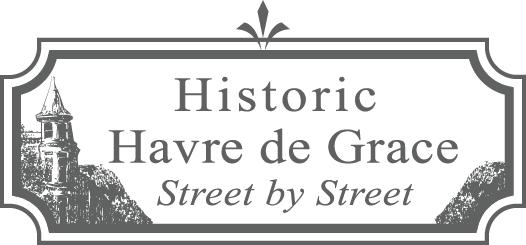Back to All Listings
633-635 Linden Lane, c. 1847, The Anderson Institute, demolished; rebuilt
A building previously on this lot in the 1860s-1870s housed the first school for free Negro children prior to the Civil War. This lot of land was sold by “a group of freed men of color” (including James Peaco) in 1847 to Aquilla Bowser and others for the benefit of the African Methodist Episcopal Church of Havre de Grace for the purpose of building a house of worship. (James Peaco/Peaker had inherited land from his father, Cupid Peaker, who died in 1847.) The building, however, burned down in 1860. In 1867, James Peaco Sr., Joseph J. Christy, Benjamin Smith, James Peaco, Jr., Sidney H. Skinner, Jesse J. Johnson, Jesse White, and David Thomas, Trustees of the Mount Zion African Methodist Episcopal Church, sold Lot #70 in Square 211 to Isaiah de Coursey, Daniel J. Ross, David Thomas, Samuel White, Isaac Bishop, George H. Johnson, and Albert Olmstead, Trustees of The Anderson Institute, "for the purpose of a School for the colored people of Havre de Grace."
The Anderson Institute was part of the Baltimore Association for the Moral and Educational Improvement of the Colored People (the “Baltimore Association”) that had been formed in 1864 to promote Negro education. The school opened in 1867; teachers at the time were Mary J.C. Anderson, who reported having 79 pupils, and J.H. Rodgers, who reported 40 pupils. The Baltimore Association paid both teachers’ salaries.
The Anderson Institute was one of four structures erected in Harford County in the years immediately following the Civil War for the purpose of educating freed slaves. Of the four structures, two were built by a public source (the federal agency commonly called the Freedmen’s Bureau, the McComas Institute and the Green Spring School) and two were built by private sources (the Berkley School—later called Hosanna School—and the Anderson Institute in Havre de Grace). The Freedmen’s Bureau (formally known as the Bureau of Refugees, Freedmen and Abandoned Lands) for free Negro children was established by an Act of Congress in 1865 to help millions of former black slaves and poor whites in the South in the aftermath of the Civil War. The Bureau provided food, housing and medical aid, established schools, and offered legal assistance. It also attempted to settle former slaves on land confiscated or abandoned during the War. However, the Bureau was prevented from fully carrying out its programs due to a shortage of funds and personnel, along with the politics of race and Reconstruction; the Bureau was disbanded in 1870.
Cupid Peaco and his sons Joseph and James were at the forefront of the struggle for equality for Blacks in Harford County. James Peaco, Sr. died in 1886. The Board of County School Commissioners “entered into possession” of the building in 1887 and remained in possession until 1913. In April 1913 the Board of Commissioners and the surviving trustees of the Anderson Institute sold their interest in the property to Frederick W. Reasin. The following month, the African Methodist Episcopal Church sold their remaining interest in it to Frederick Reasin also. Frederick Reasin had served as Harford County Sheriff in the early 1900s and his father was Samuel H. Reasin (1818-1872), a member of the Board of County School Commissioners of Harford County in 1865.
Frederick W. Reasin and his wife, Emma, owned this property until their deaths in 1940 and 1941. It is most likely that the Anderson Institute building was demolished by them and that they built the current blue apartment building on the lot ((however, some sources say that the current building is that of the Anderson Institute). The school is marked on the 1894, 1899, and 1904 Sanborn Fire Insurance Maps as “colored school,” and on the 1910 Map as “School, Negro.” However, the 1921 and 1930 Sanborn Maps show a “D” for dwelling in the location of the school and in 1955 it is marked as Apartments (reflecting the current building on the lot).
After the Reasins died, a court trustee sold this land, along with adjoining lots facing onto Ontario Street, to George C. Pensell (1918-1998), and his wife, Alice M. Pensell in 1942. They are best known in Havre de Grace for founding the Tidewater Marina at the foot of Bourbon Street. This lot and blue apartment building continues to be part of the 634 Ontario Street property, which has 21,000 square feet of land.
The parking lot to the east of this blue apartment building had another house in the past that was razed at some point.
County Records
See 634 Ontario Street.
See 634 Ontario Street.
